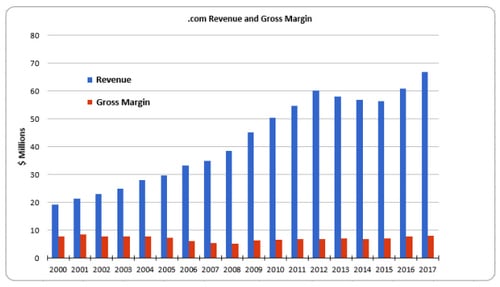No matter what Verisign charges them, registrar profits on .com are limited by competition.
Last year the U.S. Government granted the ability for Verisign (NASDAQ: VRSN) to raise prices on .com domain names pending approval from ICANN.
Where does that extra money go? As the sole wholesaler of .com domain names, every penny that Verisign raises the price of .com domain names goes to its bottom line. Domain registrars do their best to pass the price increase on to consumers, but their margins continue to be held down by the competitive market.
Indeed, while domain registrars can charge whatever they want for .com, market forces prevent them from charging much over the wholesale cost.
Take a look at this chart from Tucows’ (NASDAQ: TCX) third quarter investor Q&A:

It shows the revenue that Tucows generates each year from .com sales as well as the gross margin. As you can see, it sells more and more .com domains but it makes roughly the same amount of margin ($8 million) each year.
Tucows CEO Elliot Noss wrote:
… .com has a strange place for us, and I suspect most registrars. It is still by far the largest top level domain. It is still by far the one that end users want as first priority. It still dominates our discussions with resellers. And over time it has become less and less impactful to our gross margin dollars. The data, going back to the launch of OpenSRS in 2000 speaks volumes. The unit volume of .com sold goes up every year. The amount of money we pay to Verisign goes up commensurately. And the amount of money that the competitive registrar market allows us to generate stays flat. Like the prairies. Amazingly flat over now 18 years. And on a % basis it has gone from us making 40% of the .com revenue generated in 2000, all the way down to 12% in 2018. We make a little under $8 million per year on .com. That was true in both 2000 and 2018. They made roughly $19 million from our .com sales in 2000. In 2017 that number was nearly $67 million. This price increase only exacerbates that trend. And of course we believe that registrars do, by far, the lion’s share of the work to generate that revenue.
While the price of .com has increased from $6.00 to $7.85 over the past 18 years, the biggest impact on profits is competition amongst domain registrars.
Noss is also pointing out that registrars (not Verisign) do the most work to promote .com’s growth.
If .com prices increase in a couple of years, Tucows will have to pass these costs directly to customers. It will probably still generate a gross margin of about $8 million a year from .com but on a bigger revenue base.
I’ve heard the argument that Verisign should have price flexibility for .com because registrars have complete price flexibility. The difference is that Verisign has a monopoly while the registrars work in a highly competitive market.






The really interesting this: would Verisign make more if they lowered the price on dot-coms? Are they at risk of minimizing profits by pushing through price increases? Would they make more by accepting the situation? Should they help foster the current domain eco-system they help create? What is there quantative data on this? Or they do everything based on emotion fuelled rants 😀
The price sensitivity on domain renewals is known to be low, meaning that prices could go 2x and people would still renew their domains.
Price sensitivity on new registrations is somewhat existent, but that can be managed thru first year discounts.
I wouldn’t agree with that at all. We see people switch registrar on renewal to save all the time. While a 1st year promotion or discount can help get the business a big difference between registration and renewal pricing tends to work against us all
That assumes registrar to be pushing prices up or down… the article is about registry pricing. We did a 1/3 registry price increase in a TLD and the renewal rates are steady.
The problem for Tucows as a wholesale registrar (not only registries work wholesale) is that they don’t make money on value-added services. Most retail operations, be registrars or resellers, make little money on domains but good money on hosting, email, SEO, design etc.
Cloudflare and their wholesale pricing is really attractive. Although the interface is quite raw and they don’t support long-term renewals – only 1 year at the moment. I did one transfer to them just to give it a try and it happened really fast.
Now that the US Government reduced the amount of regulation on .com prices what exactly will registrars do? The representative data that you present here from a wholesale registrar, where resellers arbitrage prices daily, cannot be the entire picture when retail registrars like Network Solutions charge $40 for a renewal. Even GoDaddy recently increased the renewal price for a .com domain by $3. Over the next six years a registrant would be charged $18 more to retain a single domain with most of that going to GoDaddy and not Verisign. Don’t you think most registrars will pass on the increase in a similar manner? Why isn’t ICA going after GoDaddy’s pricing, which as you point out, is not regulated?
Um, because if I don’t like Godaddy’s prices I can just switch to another registrar with lower prices